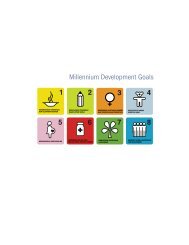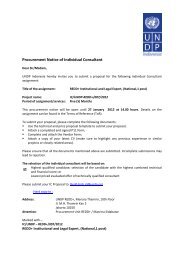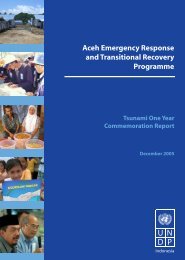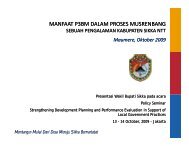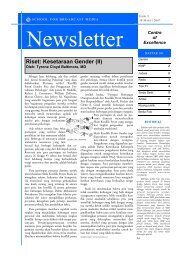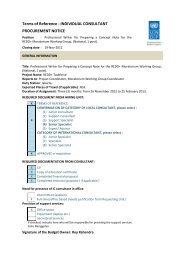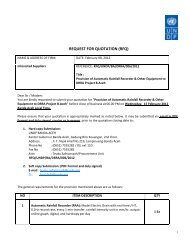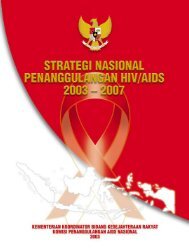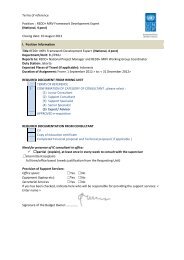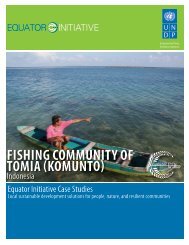Download the Indonesia Human Development Report 2004. - UNDP
Download the Indonesia Human Development Report 2004. - UNDP
Download the Indonesia Human Development Report 2004. - UNDP
Create successful ePaper yourself
Turn your PDF publications into a flip-book with our unique Google optimized e-Paper software.
Table 2.3 – Top 10 districts in GDI ranking, 2002DistrictLife Expectancy Adult Literacy Mean year of Contribution to HDI GDI(years) (%) schooling (years) earned income (%)Female Male Female Male Female Male Female Male1 Kota Salatiga 72.1 68.1 89.2 97.5 8.9 10.2 47.5 52.5 72.8 72.52 Kota Ambon 73.9 70.0 98.5 99.3 10.1 10.6 50.6 49.4 72.7 71.33 Kota Pematang Siantar 72.8 68.9 98.2 99.3 9.9 10.7 36.2 63.8 74.1 70.44 Kota Denpasar 74.2 70.4 92.0 97.4 10.0 11.5 32.7 67.3 74.9 70.15 Kota Banda Aceh 70.5 66.5 98.5 99.4 10.9 11.4 42.0 58.0 71.9 69.76 Kab. Toba Samosir 68.8 64.9 93.2 99.2 8.4 9.9 52.0 48.0 69.5 69.37 Kota Kediri 70.6 66.6 92.9 97.9 8.8 9.9 42.8 57.2 66.1 69.18 Kota Yogyakarta 74.8 70.9 91.7 98.6 10.0 11.5 33.9 66.1 70.8 68.89 Kota Batam 71.6 67.7 98.8 99.3 10.9 10.9 40.1 59.9 73.2 68.610 Kab. Karo 72.9 69.0 96.0 99.4 8.3 9.1 39.9 60.1 70.9 68.5160,000 higher ‘structural’ echelons, <strong>the</strong> proportions dropto 16%. Most of <strong>the</strong>se women are employed instead in<strong>the</strong> 1.9 million ‘functional’ jobs, such as teachers andnurses (Figure 2.11).Women’s lower status is also reflected in public life.Although <strong>Indonesia</strong> has a woman president, in <strong>the</strong> DPRin 2003 <strong>the</strong>re were only 45 women among <strong>Indonesia</strong>’s462 MPs. This situation did not improve much after <strong>the</strong>2004 election, despite <strong>the</strong> new election law passed in 2003which indicated that 30% of candidates on party listsshould be women. Clearly parties did not abide by this.Women’s empowerment generally is registered in <strong>the</strong>Gender Empowerment Measure (GEM), whichincorporates a series of indicators, including women’srepresentation in parliament, <strong>the</strong> proportion of women insenior official managerial and technical staff positions atwork, as well as women’s non-agricultural wagescompared with men’s. The global human developmentreport does not include <strong>Indonesia</strong> among <strong>the</strong> 70 countriesfor which it calculates a GEM. But taking <strong>the</strong> valuecalculated by BPS for 2002 of 0.546, this would rank<strong>Indonesia</strong> at 33 out of 71 – between Cyprus and Estonia.On this basis <strong>Indonesia</strong> also has a GEM rating superior toa number of o<strong>the</strong>r countries in <strong>the</strong> region, including <strong>the</strong>Philippines, Malaysia, Japan, Thailand, and <strong>the</strong> Republicof Korea. The GEM value for 2002 represents a slightincrease over that calculated for 1999. Among <strong>the</strong>provinces, women in Central Sulawesi occupy <strong>the</strong> topposition <strong>the</strong> GEM ranking in Central Sulawesi, largelybecause of non-agricultural work where <strong>the</strong>y appear tobe paid much <strong>the</strong> same as men. Last in <strong>the</strong> ranking isNorth Maluku primarily because <strong>the</strong>re are no women in<strong>the</strong> provincial parliament. Bali is also low in <strong>the</strong> GEMranking for <strong>the</strong> same reason.A fragile democracyThe democratic system restored following <strong>the</strong> collapseof <strong>the</strong> previous regime has at least survived, and to someextent been streng<strong>the</strong>ned. But many of <strong>the</strong> underlyingweaknesses remain. On <strong>the</strong> electoral front, <strong>the</strong>re havebeen some significant changes in procedure.Previous elections have been based on a ‘closed list’system where voters could only choose <strong>the</strong> party. Thishas <strong>the</strong> disadvantage that members feel more beholden to<strong>the</strong>ir party to get <strong>the</strong>m on <strong>the</strong> list than to <strong>the</strong>ir electorate,so <strong>the</strong>y have little incentive to cultivate <strong>the</strong>ir constituents.An opinion poll in April 2003, for example, found thatonly 2% of respondents could name a DPR member whorepresented <strong>the</strong>ir province. 10 The outcome of <strong>the</strong> 2004election may be somewhat better in that it is based on anopen list system that gives voters for <strong>the</strong> DPR and DPRDan opportunity also to nominate a candidate. For <strong>the</strong> DPR<strong>the</strong> electoral districts were also somewhat smaller.Figure 2.11 – Distribution of women in <strong>the</strong> civilserviceSource: Statistik <strong>Indonesia</strong> (2002)10 IFES (2003).18National <strong>Human</strong> <strong>Development</strong> <strong>Report</strong> 2004



